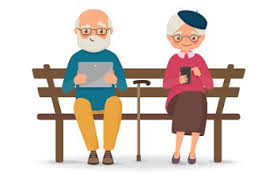AARP research h ighlights changes in technology adoption. What a difference more than a decade makes. Consider a long-ago AARP document that examined technology use of the 65+ population. Remember Healthy@Home in 2008? You probably don’t, but you should read it. Kudos to Linda Barrett who led the production of this milestone report. The iPhone had just been released in June of 2007, so this survey did not ask about smartphone use – there was no Digital Health (a "check engine light for your body!"); the Longevity Economy hadn’t been invented; Fitbit was a 2007 new clip-on tracker, and Facebook was still a campus toy. The survey was fielded in December of 2007 with a population of 907 adults aged 65-98 (the mean age was 74). This population is rarely surveyed today, despite the growing lifespan of the 65+. Much was revealed, though it is another example (as if we needed one) that the more things change, the more they don’t.
ighlights changes in technology adoption. What a difference more than a decade makes. Consider a long-ago AARP document that examined technology use of the 65+ population. Remember Healthy@Home in 2008? You probably don’t, but you should read it. Kudos to Linda Barrett who led the production of this milestone report. The iPhone had just been released in June of 2007, so this survey did not ask about smartphone use – there was no Digital Health (a "check engine light for your body!"); the Longevity Economy hadn’t been invented; Fitbit was a 2007 new clip-on tracker, and Facebook was still a campus toy. The survey was fielded in December of 2007 with a population of 907 adults aged 65-98 (the mean age was 74). This population is rarely surveyed today, despite the growing lifespan of the 65+. Much was revealed, though it is another example (as if we needed one) that the more things change, the more they don’t.
A few highlights from the report catch the eye. To ask the questions in this survey, responders were shown still pictures of products from a Leading Age video. Only one third of the 65+ had broadband in the home (the rest used dial-up) or had gone online at the time of this survey. The older they were, the less likely to search for health information online or to trust online sources. They were also less willing to use a computer to interact with people at a distance (Skype had just surfaced in 2003). Perhaps seeing the future, 6 in 10 thought that “personal computers will cost too much to install (62%), maintain (59%) and may not be something I need (58%).” The 65+ population thought favorably about home safety devices, including mitigating losses from impairment (vision, mobility) – but only for others, not for themselves.
What’s changed in adoption by 2018? By the time of the 2011 report Healthy@Home 2.0, it was apparent that the in-home PC market was saturated. By then, 71% of the 65+ were using PCs to communicate with family and friends. Caregivers were increasingly using technology to help them manage care (although they still objected to being called caregivers). By 2018, in another AARP report, tech attitude differences between the 70+ and younger population were apparent. While 90% of all adults owned a computer or laptop, those aged 70+ were more likely to use them, along with feature phones -- smartphone adoption had reached just 55% in that group. Among those under the age of 70, text messaging had taken over as the primary tool to stay connected, replacing email (and sadly, the telephone conversation, which was pretty much gone by 2015).
Telemedicine was positively perceived in 2008, but…More than half of older adults said they would like to be able to monitor their health status at home, sending information to their doctor via telephone and email. And in fact, by 2008, the VA had completed a study about the efficacy of in-home telehealth for veterans – in particular, aside from the claims of cost effectiveness, those that had the devices felt more connected to their care providers. That was the good news. By 2019, the so-called tipping point in utilization by doctors has not been reached, though, perhaps it is just around the corner – the VA being the first to allow doctors to 'practice' medicine across state lines. However, an October poll showed that older adults would still prefer in-person visits and anyway, have generally not encountered telehealth offerings. Their expressed concerns were nearly identical to those noted in 2008 -- more than half did not know if their doctor offered and nearly half worried whether the technology would work. Meanwhile, only one-third of hospitals and 45% of doctors actually offer telehealth services. Oh yes, and does it save money? The jury is still out.


Comments
From Jennie Chin Hanson
Superb perspective piece across a 12 year (short!) span.